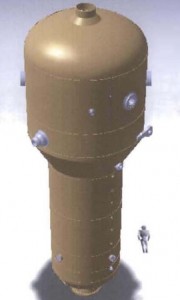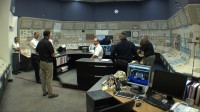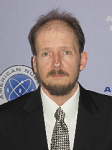San Onofre debate now more public – and more technical
The debate over the continuing investigations into steam generator U-tube problems at San Onofre Nuclear Generating Station (SONGS) last week entered a new phase of heightened publicity and public scrutiny as the Nuclear Regulatory Commission (NRC) released Mitsubishi documents which detailed that company's investigations into the root causes of the problems.
 Friday, March 8, saw the release of a pair of documents which had been redacted by Mitsubishi Heavy Industries (MHI) (redaction here means that sensitive corporate information that competitors could use to advantage had been removed). This followed the revelation within the previous weeks that an original of this document had somehow fallen into the hands of US Senator Barbara Boxer and US Representative Ed Markey, who then touted the documents as a "smoking gun" showing that plant operator Southern California Edison (SCE) had deliberately installed steam generators already known to be bad. Allegations circulating the internet pointed to a "flawed design by Southern California Edison" and revealed a lack of clarity in the design process for such equipment. SCE quickly and strongly responded to the allegations.
Friday, March 8, saw the release of a pair of documents which had been redacted by Mitsubishi Heavy Industries (MHI) (redaction here means that sensitive corporate information that competitors could use to advantage had been removed). This followed the revelation within the previous weeks that an original of this document had somehow fallen into the hands of US Senator Barbara Boxer and US Representative Ed Markey, who then touted the documents as a "smoking gun" showing that plant operator Southern California Edison (SCE) had deliberately installed steam generators already known to be bad. Allegations circulating the internet pointed to a "flawed design by Southern California Edison" and revealed a lack of clarity in the design process for such equipment. SCE quickly and strongly responded to the allegations.
Allegations in this matter made by Friends of the Earth (FOE) turned out to be, in fact, complete falsehoods. So it might be best to examine some of the facts surrounding this case and, as one recent San Diego Union Tribune op-ed piece hinted, "let the experts figure it out."
RSGs and the Process of Replacement
RSG stands for "Replacement Steam Generator," and the mystery in the public eye surrounding this process seems only to be growing.
In 2004, the owners of SONGS signed a contract with Mitsubishi to build four RSG's for the two reactor plants on site. The San Onofre nuclear plants were originally built by Combustion Engineering (CE), which was merged out of existence some years back (Westinghouse is now essentially the lineal descendant). SCE chose to contract with Mitsubishi, which had been manufacturing steam generators of various types since 1970, to fabricate steam generators for the plants.
In this process, SCE provided to Mitsubishi a set of specifications-design standards to which the equipment had to adhere-for the steam generators. The specifications address not just size and weight, but a number of more involved details, such as desired materials. Mitsubishi then began work on a custom design for these plants based on the specifications. Mitsubishi used as a reference design steam generators it had built as RSGs for Fort Calhoun Nuclear Generating Station-also a Combustion Engineering plant, but smaller than San Onofre. A typical steam generator from a CE plant is seen below.
 In the original conception of pressurized water reactor plants, the replacement of steam generators was not intended. In these old designs, however, deficiencies became apparent after some time in operation (which varied widely depending on the plant and particular design), so replacement of these massive pieces of equipment had to be considered. In some cases, such as Trojan Nuclear Power Plant in Oregon, replacement was required, but instead the plant shut down permanently and was dismantled when the cost structure and public opinion went against them. This example has not been the norm; and in fact many plants have replaced steam generators.
In the original conception of pressurized water reactor plants, the replacement of steam generators was not intended. In these old designs, however, deficiencies became apparent after some time in operation (which varied widely depending on the plant and particular design), so replacement of these massive pieces of equipment had to be considered. In some cases, such as Trojan Nuclear Power Plant in Oregon, replacement was required, but instead the plant shut down permanently and was dismantled when the cost structure and public opinion went against them. This example has not been the norm; and in fact many plants have replaced steam generators.
The original reactor vendors are not using the same facilities or contracts they did when the plants were newly built. The downsizing of the nuclear manufacturing complex after a new construction sales dropoff in the late 1970s led toward an almost wholesale outsourcing of RSG construction today. For example, since Westinghouse ended fabricating RSGs in the USA, it has used ENSA (Spain), Ansaldo (Italy) and Doosan (South Korea) as subcontractors for RSGs, while other RSGs have been supplied to US utilities by AREVA and Mitsubishi. A counter example to this trend is Babcock & Wilcox, which has a contract to replace Davis-Besse's steam generators this year, as well as a contract for OEM replacements at TVA's uncompleted Bellefonte units.
In the earliest steam generator replacements, only parts of the steam generators were replaced, but eventually entire units began to be fabricated. Eventually, as with any technology, improvements were made in design, and RSGs began to be fabricated with the same new, improved materials-such as Inconel-690 tubes-and techniques that were being employed in steam generators being fabricated for entirely brand-new reactor plants. Replacing steam generators gave operators an opportunity to incorporate both better materials and better designs; the possibility of uprating could also be realized if more heat transfer area were available in the RSGs. The NRC, recognizing the need to ensure safety with this as with every other practice in the industry, requires that replacement steam generators comply with a strict code that dictates what can, and cannot, be changed-and requires license amendments be applied for and approved when needed.
The above process, as described, is fully what occurred at San Onofre: SCE provided specifications to MHI, which then completed detailed design and fabrication of the steam generators.
Design Problems
In October 2012, after discovery of the issues leading to San Onofre's RSG failure, MHI revealed it had made errors in computer analysis of the steam generator design. An SCE release provided to this author last October contains the following statement:
The Nuclear Regulatory Commission (NRC) determined that computer modeling used during the design phase by the manufacturer, Mitsubishi Heavy Industries, underpredicted the thermal hydraulic conditions in the steam generators which contributed to the unstable tube vibration. The unstable tube vibration caused the unexpected wear in the steam generators.
As we are now aware, this is only a part of the story. The phenomenon behind the vibration is called Fluid Elastic Instability (FEI). The real problem that allowed FEI to cause vibration serious enough to wear through tubes has to do much more with fundamental design assumptions and then, later, actual fabrication.
Reading of the linked MHI documents reveals clearly that the problem is partly theoretical, partly physical. On the one hand, an assumption in force in steam generator design industry-wide has held that "if out of plane FEI is prevented by design, in-plane FEI can not occur." This has been proven wrong-at least in the San Onofre steam generators-although it must be stated clearly that this event at San Onofre is the first confirmed occurrence of in-plane FEI known in the industry.
We also see in the report (again, quite clearly) that the design of the Anti-Vibration Bars, which restrain the U-tubes, was slightly modified-and was thought to be improved-in Unit 3. What actually happened was that making the parts to finer (closer) tolerances reduced their contact force-and thus their ability to restrain the U-tubes-and helped lead to the motion-related impact wear.
Public Relations, and Events Outside Regulatory Action
As might be expected, continuous attention is given this situation by the NRC, which has held numerous meetings, inspections, and public hearings on this issue. The NRC is tasked with ensuring that the plant is safely operated and that it meets all technical requirements. The NRC certainly appears to be solidly on the job, given the sheer number of Requests for Additional Information (RAIs) that it has issued.
Politics has also become an integral part of this story. Senator Boxer sent a letter to the NRC stating that she had proof that MHI and SCE knew that the equipment was flawed. The letter was issued prior to any release, or public analysis, of the MHI documents.
In her letter, Boxer "calls on the NRC to promptly initiate an investigation" in the midst of what surely must be one of the most deeply technical investigations in NRC history-or in the history of the manufacture of steam generators. This clearly reveals a lack of perspective on where the MHI report falls in the path between discovery of the issues and development of a resolution.
In response to this ongoing situation, SCE yesterday issued a press release in which Pete Dietrich, SCE Senior VP and Chief Nuclear Officer, states:
The anti-nuclear activists have called the MHI report a 'bombshell' which couldn't be further from the truth .... In fact, the MHI letter explains that SCE and MHI rejected the proposed design changes referenced in the evaluation because those changes were either unnecessary, didn't achieve objectives or would have adverse safety consequences.Our decisions were grounded in our commitment to safety. SCE did not, and would never install steam generators that it believed would impact public safety or impair reliability.
SCE goes on to state, "The MHI letter specifically confirms that at the time the replacement steam generators were designed, MHI and SCE believed that {excerpt from MHI report} 'the replacement steam generators had greater margin against U-bend tube vibration and wear than other similar steam generators'."
In the release, the Nuclear Energy Institute's Scott Peterson adds that claims by anti-nuclear activist group Friends of the Earth (whose anti-nuclear creed is clearly stated on its home web page) are part of a campaign of moving "from plant to plant with the goal of shutting them down." Pointing out the cherry-picked statements that both Senator Boxer and FOE are trying to posit as the 'proof' of wrongdoing of SCE, Peterson says: "Not providing proper context for these statements incorrectly changes the meaning and intent of engineering and industry practices cited in the report, and it misleads the public and policymakers."
What's Next?
This author spoke to SCE's Jennifer Manfre yesterday about where this continuously evolving situation is headed. SCE would like to test operate Unit 2 at a 70% power limit for five months, followed by another complete RSG inspection, to assess if the calculational determination that FEI will be avoided here is demonstrated in operation. Manfre stated that this 70% limit is "very conservative-we set a limit for avoiding FEI, and then set a new arbitrary limit below that to ensure safety, as is always our priority."
NRC has raised some questions regarding the limit and has asked SCE to be able to demonstrate that the plant is actually safe at 100% power during any of this 70% testing which, as Manfre points out, "goes to the technical specifications for the plant." Manfre relates that SCE is preparing to submit, shortly, to NRC its Operational Assessment showing that the plant is indeed safe at 70% and also at 100% for this testing, saying "we essentially did both, to satisfy NRC and technical specifications."
Manfre also clearly pointed out that the role of SCE in the RSG process is essentially that of being a customer with a required set of specifications, to which a detailed design is completed by a vendor (in this case, Mitsubishi). SCE did take part in some of the design process (for example, the design of the AVBs) but is not responsible for the overall design of the RSGs. Mitsubishi, who is responsible, has already begun warranty payments to SCE.
When Manfre was asked to speculate as to what a final resolution to this problem might look like-and was offered examples of a new operating license at a lower power rating to avoid FEI, or physical repairs to the steam generators to allow the full presently-rated power rating-she said "we're not even close to that yet; we need to get through this period of testing." Anyone in the nuclear industry (and, it might be added, many other industries) can relate to the need to conduct operational testing and analysis before selecting final operational fixes to a complicated technical and physical problem which involves public safety. Boeing's problems with the 787 Dreamliner battery fire problem comes to mind as a timely parallel-as does the FAA's handling of the situation.
 Quite clearly with the voluntary release of the MHI documents, the process of investigation has unparalleled transparency for this sort of highly technical matter. In a February 26 SCE press release, Dietrich says that "this question and answer process is an important part of safety-based technical solutions in the nuclear industry, and it strengthens our ability to communicate to stakeholders the safety principles and proven industry operating experience that the Unit 2 restart plan was built upon," in reference to the open nature of the NRC Request for Additional Information Process. The latest MHI release builds upon this process.
Quite clearly with the voluntary release of the MHI documents, the process of investigation has unparalleled transparency for this sort of highly technical matter. In a February 26 SCE press release, Dietrich says that "this question and answer process is an important part of safety-based technical solutions in the nuclear industry, and it strengthens our ability to communicate to stakeholders the safety principles and proven industry operating experience that the Unit 2 restart plan was built upon," in reference to the open nature of the NRC Request for Additional Information Process. The latest MHI release builds upon this process.
This open process between plant operator and Federal regulator has now been added to-or, depending on point of view, detracted from-by inclusion in the public domain of releases of sections of the MHI documents taken out of context. Dietrich, from yesterday's SCE press release:
As with all engineering evaluations, the MHI letter and report describe a technical evaluation process and need to be read in their entirety to understand the conclusions reached .... The activists are taking portions of paragraphs and sentences out of context, and using them as the basis of their allegations that SCE knew of design defects when the generators were installed, but failed to make changes to avoid licensing requirements. That is untrue.
Manfre also relates that another 'next step' will be the impending full cost summation of the entire RSG process to the California Public Utilities Commission (PUC). The California PUC is under great pressure politically and must demonstrate that all rate impacts are fair and reasonable. She also points out an upcoming Atomic Safety & Licensing Board hearing covering the scope of the required license amendments.
All of the developing actions and public Federal regulatory hearings can be found on the NRC's dedicated San Onofre pages. Developments and press releases from Southern California Edison on this situation can be found on its own dedicated SONGS website.
[Illustrations of San Onofre Nuclear Generating Station courtesy Southern California Edison]
_________________________________
 Will Davis is a consultant to, and writer for, the American Nuclear Society. In addition to this, he is a contributing author for Fuel Cycle Week, and also writes his own blog Atomic Power Review. Davis is a former US Navy Reactor Operator, qualified on S8G and S5W plants.
Will Davis is a consultant to, and writer for, the American Nuclear Society. In addition to this, he is a contributing author for Fuel Cycle Week, and also writes his own blog Atomic Power Review. Davis is a former US Navy Reactor Operator, qualified on S8G and S5W plants.







